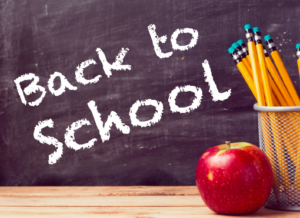As the summer holidays draw to a close, the anticipation for the start of school grows. For parents and children alike, the start of school, and all that will come in the first term, can be more than daunting.
Getting used to a new teacher, finding the way around school again, following routines and school structures (which had been long forgotten in the North East summer sunshine or rain) and catching up with friends.
It is a busy and exhausting time for any child, but for those with additional or multiple support needs (ASN/MSNs) it can be especially draining.
Here at SensationALL, we have had our thinking caps on to come up with some of our TOP TIPS for going back to school.
1. Explore Emotions
This is a difficult one to address, but as important as getting the school bag ready and uniform on.
Children with MSNs may feel that they are the only one finding it hard, the only one who doesn’t fit in, the only one forgetting their pencil, jotter, gym kit or the only one feeling scared. The idea of being “the only one” is as untrue as there being a “perfect person”.
Explore the concerns, worries and challenges your child may have: relieving anxieties by talking through situations, particularly those relating to socializing and making new friends.
Discuss and share practical ways they can try to address these concerns. Highlight that their peers are likely to feel the same. They won’t be “the only one” and building awareness that others may feel the same can bring about feelings of inclusion and comfort.
2. Get familiar
For children with sensory sensitivities it is really important to put in the prep work ahead of the school term starting.
Try on new uniforms, cut out labels if required, wash them a few times so they are familiar and soft and build up tolerance by wearing them around the house. This goes for new school shoes too!
Don’t stop at clothing and shoes, try out any new items like water bottles, lunch boxes, school bags, pencil cases etc.
The more familiar and tolerant your child is to the items which will be a constant throughout their school days, hopefully the better they can cope with the range of new sensory inputs they will experience. Remember to include any calming strategy/resource they might have.
3. Organisation
Whether you are helping an older child develop their organisational skills, or you’re organising for a younger child, this will help with the ease of transitioning back into the school day.
Practice getting the bag organised the week before, packed lunch, lunch card, gym kit, use visuals and checklists where appropriate. The smoother the morning operation runs, the lower the stress and anxiety levels all round!
For any child, turning up to school and finding out you’ve forgotten something can cause a great deal of distress and impact learning. Older children should take a very active part in organising themselves for school as this will contribute towards being more independent, and learning these skills young builds confidence and a great foundation for later.
4. Go along beforehand
If your child is starting at a new school, and/or finds settling into different environments challenging, get in contact with the school to go along the week before if possible.
This can be really helpful if physical disability presents an added worry to the child, for example, getting through the corridors, around the playground, getting to the lunch hall and very importantly to most children, actually getting lunch!!!
Identifying safe or quiet areas can also help alleviate anxiety and help develop proactive It can act as a trial run before the hustle and bustle, a good opportunity to familiarise and to try out different strategies to help your child throughout the school day.
5. Visual structure
Try putting together a picture wall chart for home, showing your child each day or the week ahead, what’s expected on each day, i.e. gym or maths or reading. After school activities can go up here if there are any and weekend ones too.
This can help children see the “bigger picture”, that maybe Tuesday isn’t a great day, but on Thursday they get to go to the gym hall or book store. A week can seem a long time, but breaking it down into days can help your child know what to expect and look forward to the days ahead.
6. Recap the positives
At the end the day, before lights out and bed, try recapping on the day’s positives, like “You did really well with completing your homework”, or even if the positive is a general, “You went to school today”. Find the positive and let it be the last thing to go through their head before drifting off to sleep. This will prepare and support the next day.
***
It goes without saying that school transitions can be anxiety provoking and challenging and usually a learning curve for all. A few basic strategies can sometimes make all the difference. Encouragement and enthusiasm can be key to reassurance and confidence building.
We hope the ‘back to school’ transition goes smoothly and we are looking forward to hearing about it! #SensationALL


